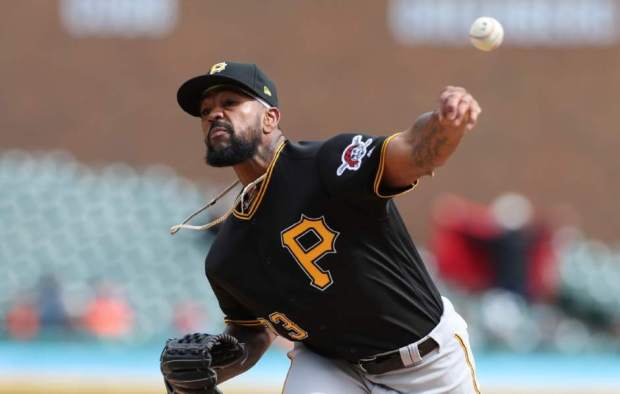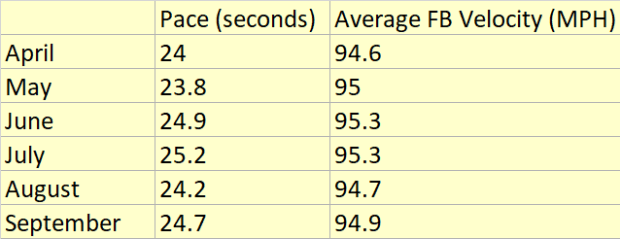How Would A Pitch Clock Impact Pirates Pitchers?
Last week, the baseball world got a peek at some potential changes MLB and the Players’ Association were mulling. A universal DH, three batter minimums for pitchers, moving the trade deadline…this was serious stuff! Too serious, actually. Turns out we jumped the gun and most of the proposals are being tabled for now. But there is one notable change Commissioner Rob Manfred could still implement before the new CBA: a pitch clock.
At this point, a pitch clock seems like an inevitability. It may or may not be in 2019 or 2020, but the pace of play initiatives will keep coming until games get shorter. It ?s debatable if a pitch clock would speed up games (see Eliza Richardson Marone’s SABR 48 presentation) or if it is a permanent solution, but that ?s a story for another day and for another writer.
Before we dive into the numbers, it ?s worth mentioning that most of the pitchers on the roster dealt with a pitch clock on their ascent to the Majors. The only two potential starters who didn ?t are Chris Archer and Jordan Lyles. Prospects Mitch Keller and J.T. Brubaker have dealt with it throughout most of their development. It may not be ideal, but the Pirates ? young staff should adapt better than other clubs because of this.
Now on to the data. PITCHf/x tracks what they call ?Pace, ? taking the time from the start of the first pitch to the end of the plate appearance and dividing it by the number of pitches minus one. So if it took Jameson Taillon six pitches and two minutes to retire a batter, then his pace was 24 seconds a pitch for that at-bat.
Last season, the Pirates finished 14th in Pace with a 23.9 second average. The proposed pitch clock will have a 20 second time limit. Nobody on the Pirates averaged that pace or better in 2018.
Of the players on the 40-man roster, Nick Kingham was the most time efficient, averaging 22.1 seconds between pitches. Edgar Santana sits on the other end of the scale, going 26.5 seconds between offerings. In general, most of the starters were faster than average. The two exceptions were Joe Musgrove and Archer, and even Musgrove cut his pace to less than 25 seconds between pitches in the second half of the season.
The relievers, on the other hand, generally take longer than average. For them, a pitch clock could be more consequential, not just because it could change their rhythm, but also their fastballs. Rob Arthur found there is a correlation between a longer pace and higher fastball velocities. Arthur writes:
?Because I adjusted for every pitcher ?s own typical velocity, this pattern isn ?t just caused by a bunch of slow-pitching, hard-throwing relievers. Instead, pitchers truly seem to gain velocity by waiting longer to deliver the ball. For every additional second they spend (up to 20 seconds), pitchers throw about .02 miles per hour harder. ?
Perhaps no Pirates pitcher embodies this more than Felipe Vazquez. In April and May last year, Vazquez ?s fastball was noticeably slower than it was in 2017. It returned to normal as the season progressed, but only as his time between pitches increased.
In the first half of the season, Vazquez ?s heater averaged 97.4 MPH — 13th fastest among relievers — with a pace of 24.9 seconds. In the second half, he took 27.8 seconds between pitches and was the hardest throwing lefty in baseball, averaging 99.1 MPH on his fastball. Those few extra seconds really made a difference.
The rest of the bullpen ?s time splits weren ?t quite as extreme, but once again, the two months where they took the most time between pitches were also the two months where they threw the hardest.
The Pirates ? bullpen averaged 95 MPH on their fastballs last season — the highest in the NL. They also threw fastballs more often than any other team. This bullpen is built on speed. Speeding them up could change that.
Admittedly, PITCHf/x ?s Pace isn ?t a perfect tool. It doesn ?t take into account pickoff attempts or mound visits that happen after an at-bat starts. Francisco Cervelli ?s quick rap sesh could be extremely helpful for Taillon, but it ?s throwing off the data for a completely superfluous stat! The nerve!
Well, the good news is Baseball Prospectus keeps track of pitcher pace as well. They even filter out the variables which inflate the pace and sort it by if there’s a runner on base. The bad news is the 2018 data is MIA. So it is with great reluctance that I ?ll travel back to the far off year of 2017. It was an analytical dark age where nobody was using openers or citing DRC+.
Take this with a grain of salt since a lot can change in a year, but here are the pitcher paces with the bases empty in 2017 for the projected rotation:
Jameson Taillon: 15.7 seconds
Trevor Williams: 16.5 seconds
Joe Musgrove: 17.3 seconds
Jordan Lyles: 18.7 seconds
Chris Archer: 20 seconds
Again, Archer and Lyles are a little slower, possibly because they did not have to deal with a pitch clock in the minors. Archer might have to speed up, which might be a good thing for him since he worked significantly faster in his best season in 2015 (21.6 Pace, 18.3 with bases empty).
The rotation would probably adapt to a pitch clock better than the bullpen, but I can ?t imagine it being good for the Pirates either way. This team is going to rely heavily on its pitching for years to come. Even if the clock rarely comes into play, it is still a hamper on the pitchers. The change may not hurt Pirates pitchers as much as other teams, but slower fastballs and rushed pitchers cannot help.





Since Archer absolutely has to adjust his hat or touch his hair between every pitch he may need either a haircut or a bobby pin in order to come in under the wire. Now if he’s loading up the baseball occasionally, then he’ll need to work on quicker primping.